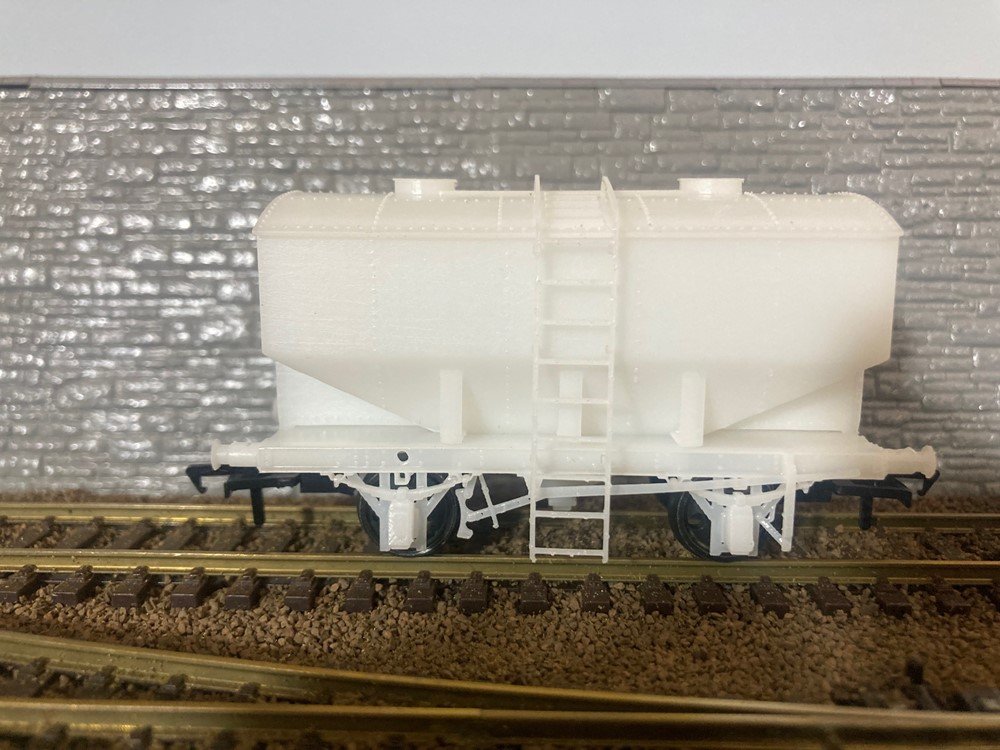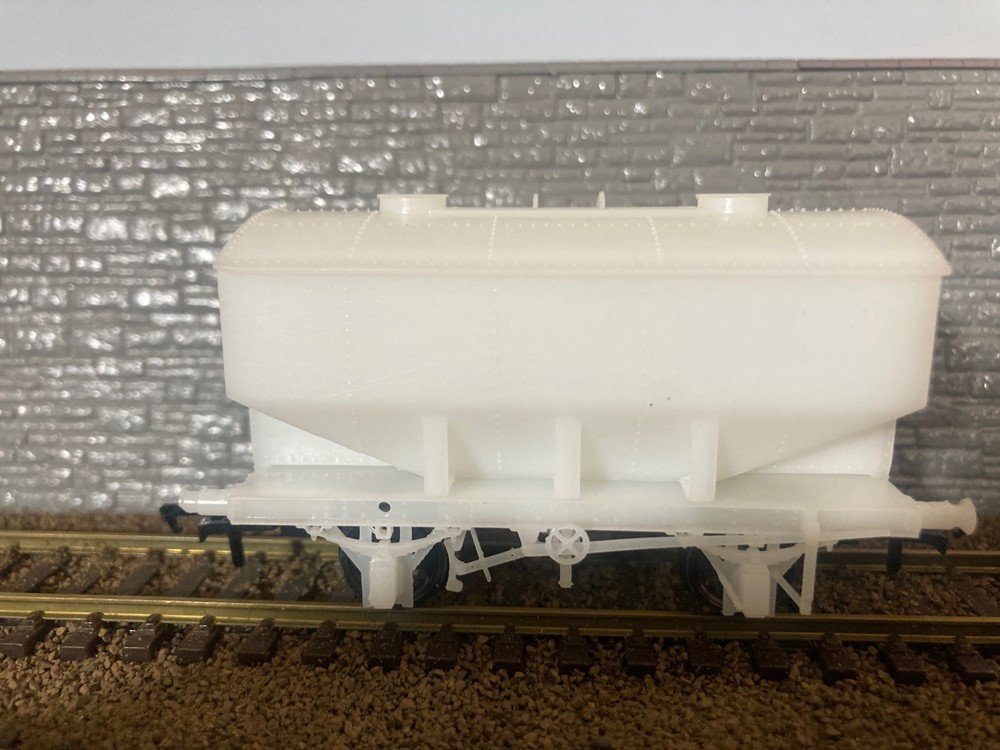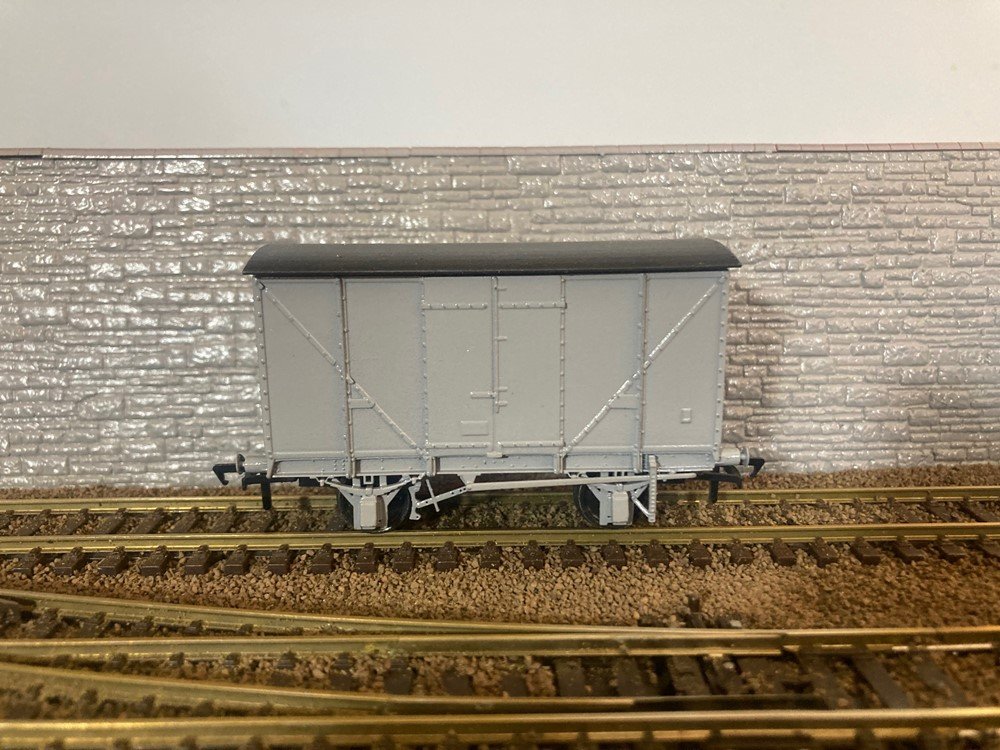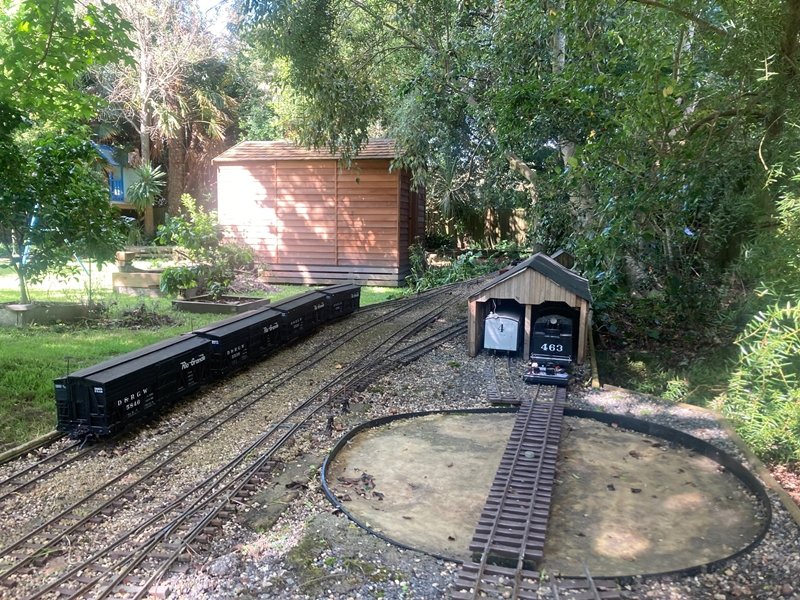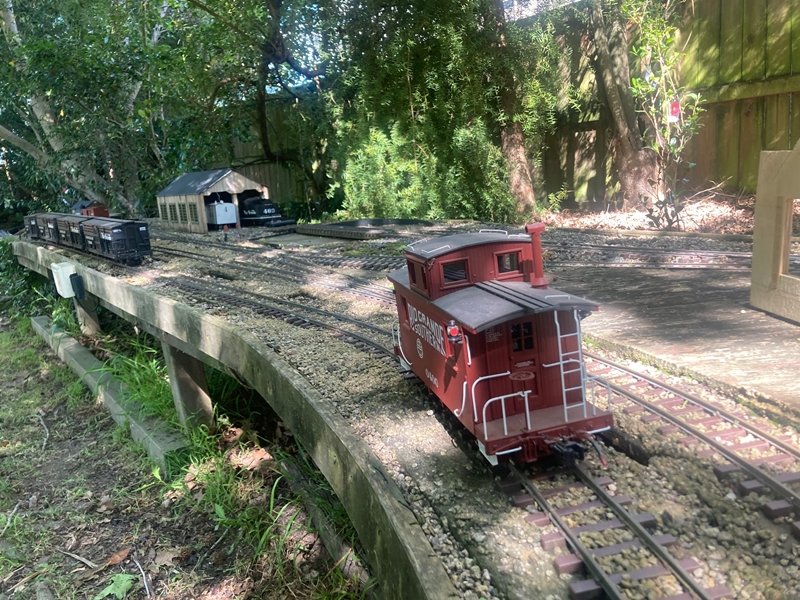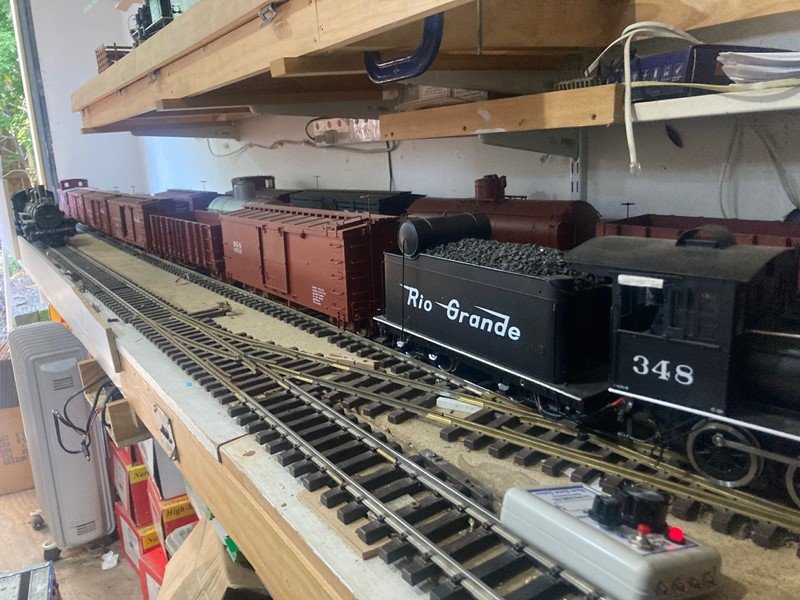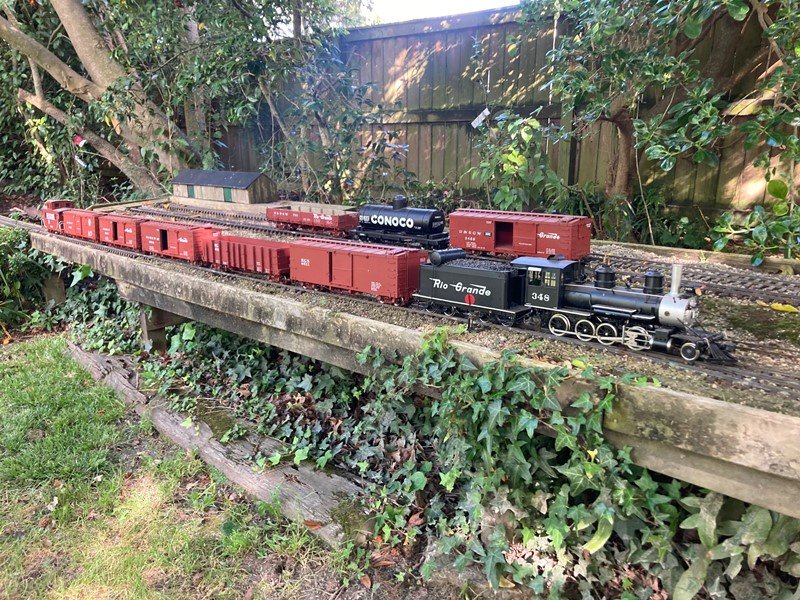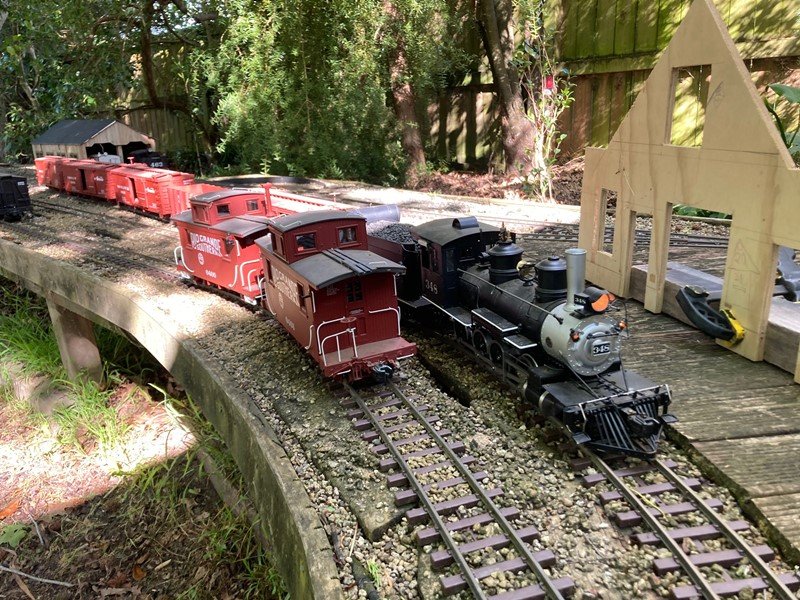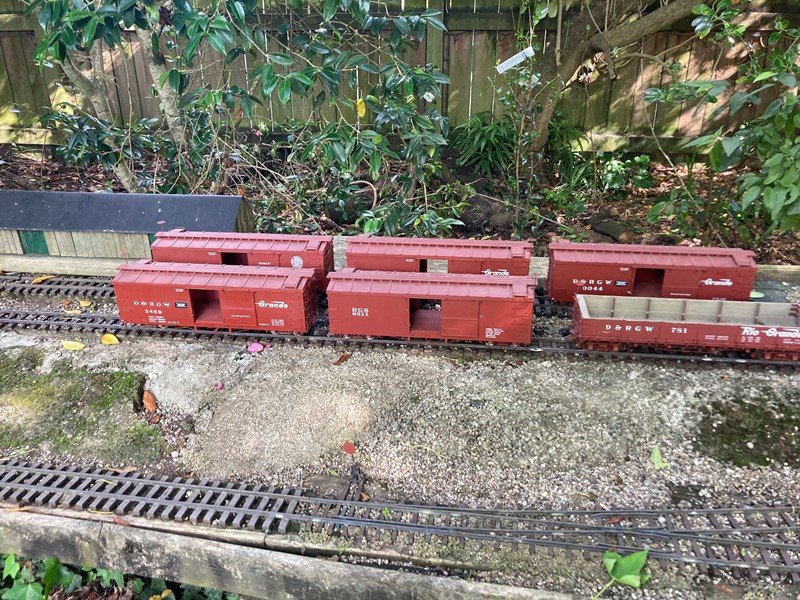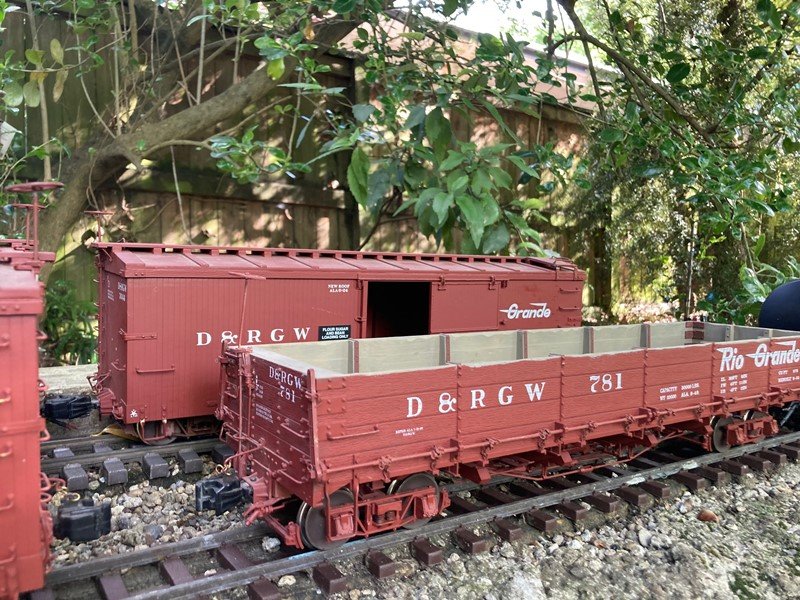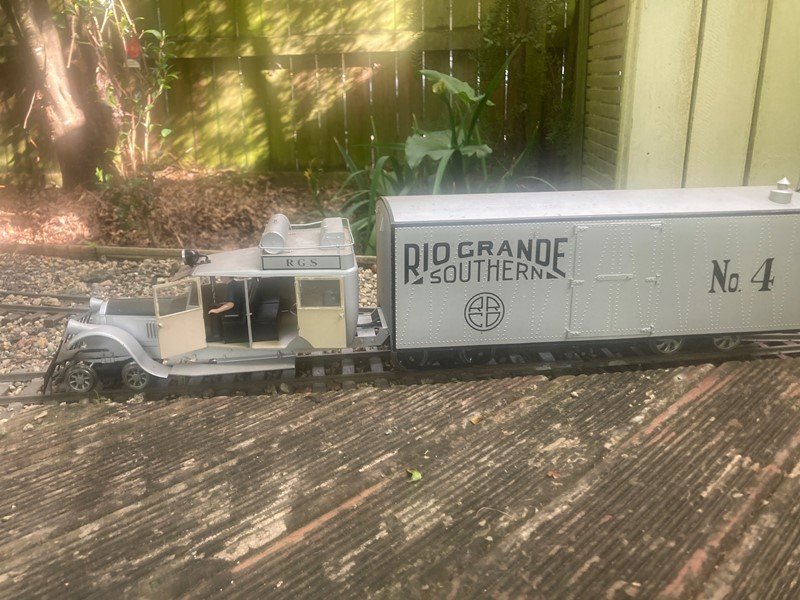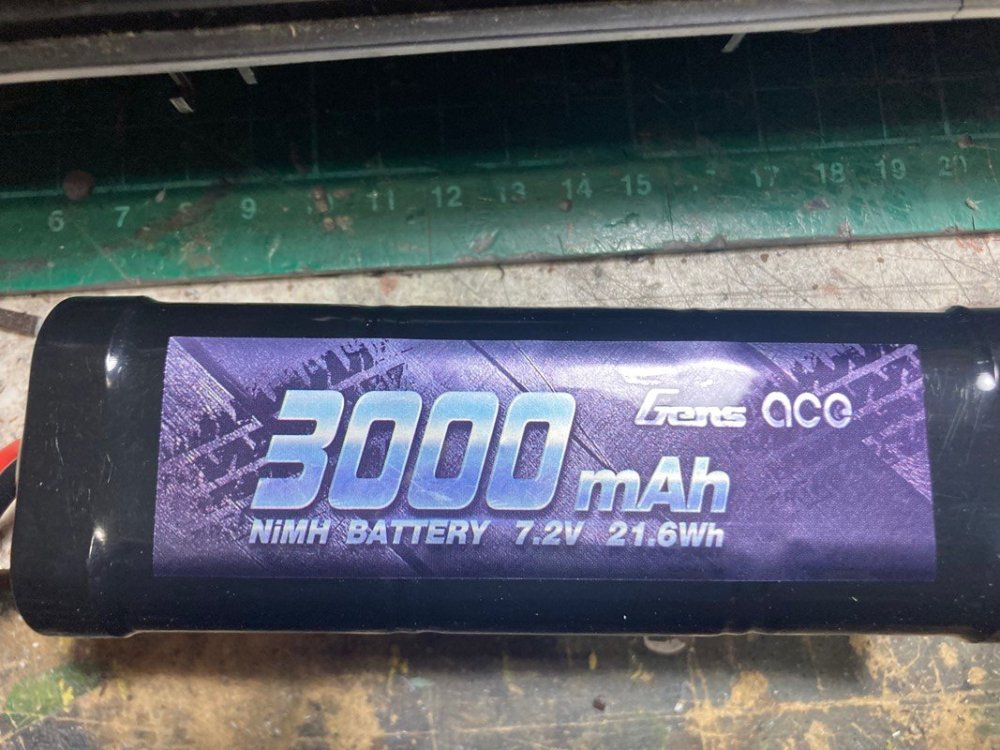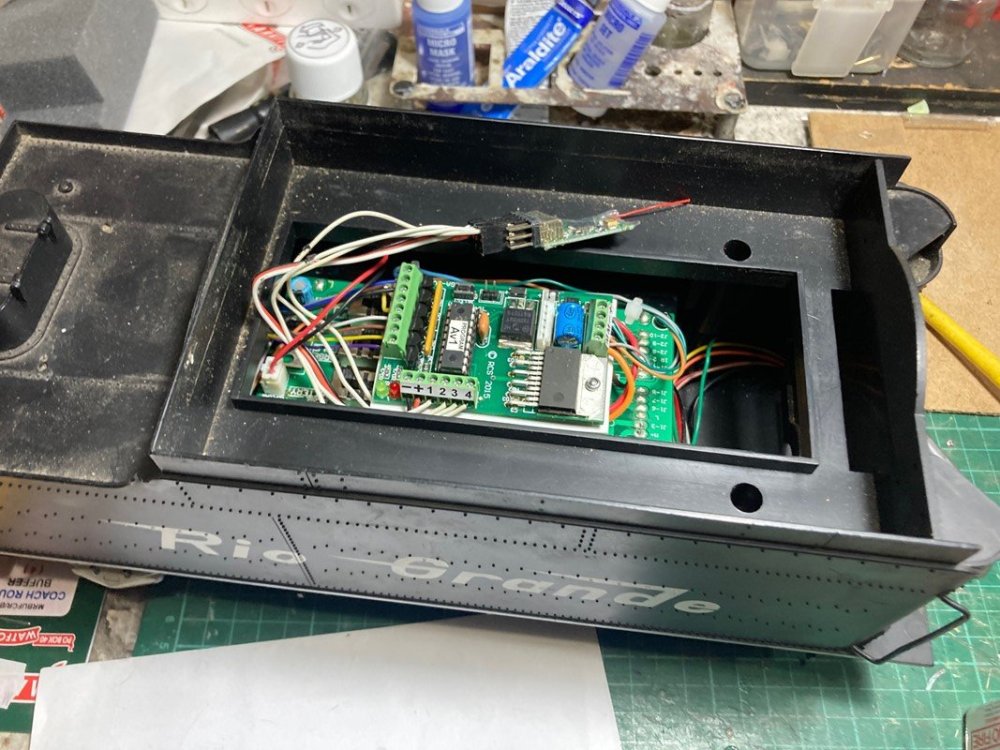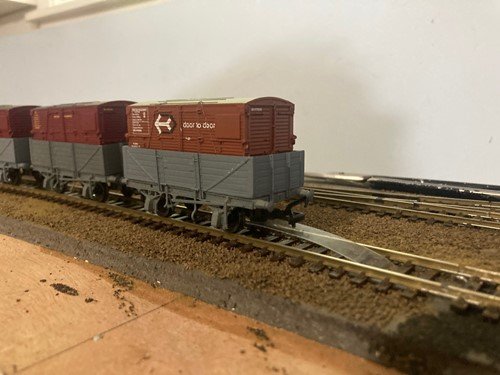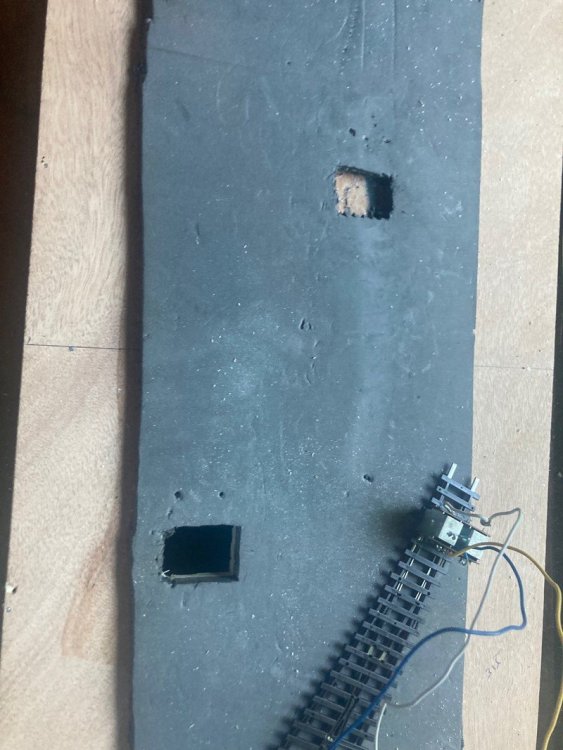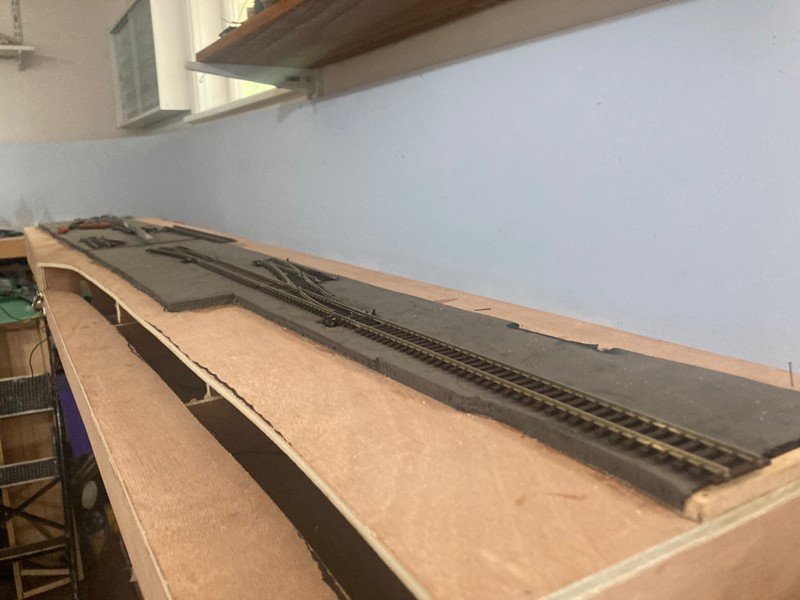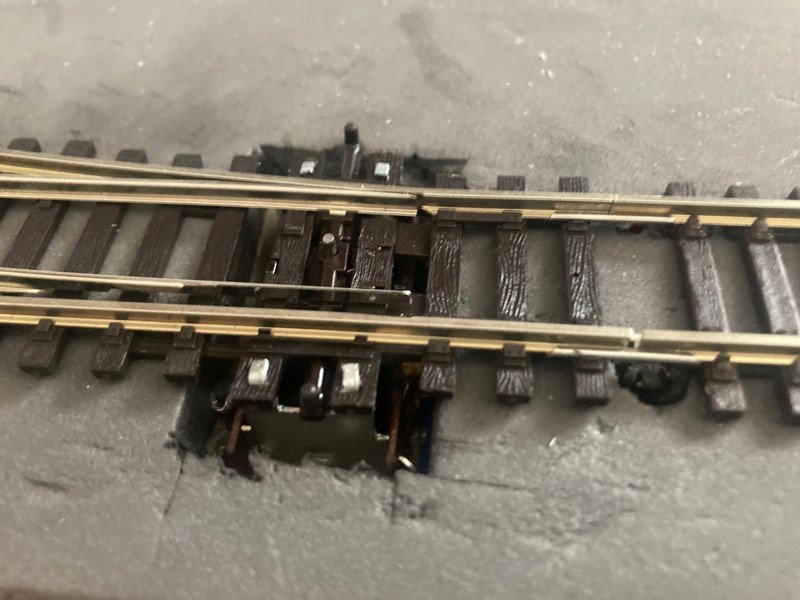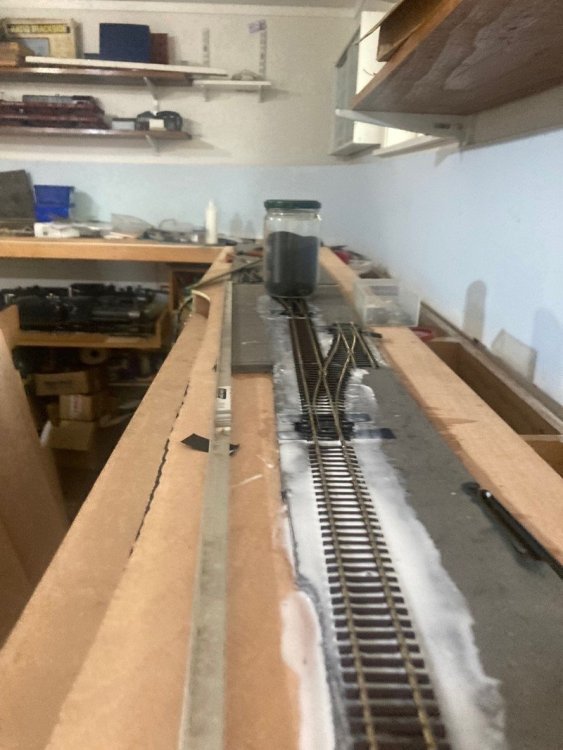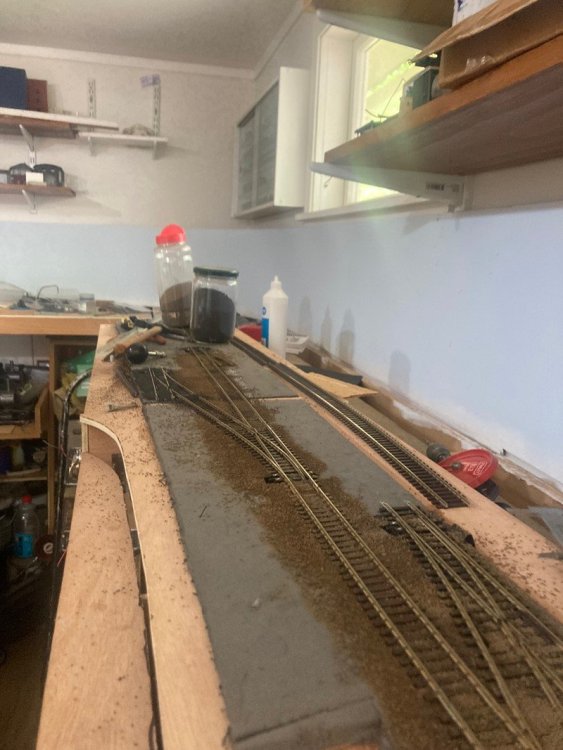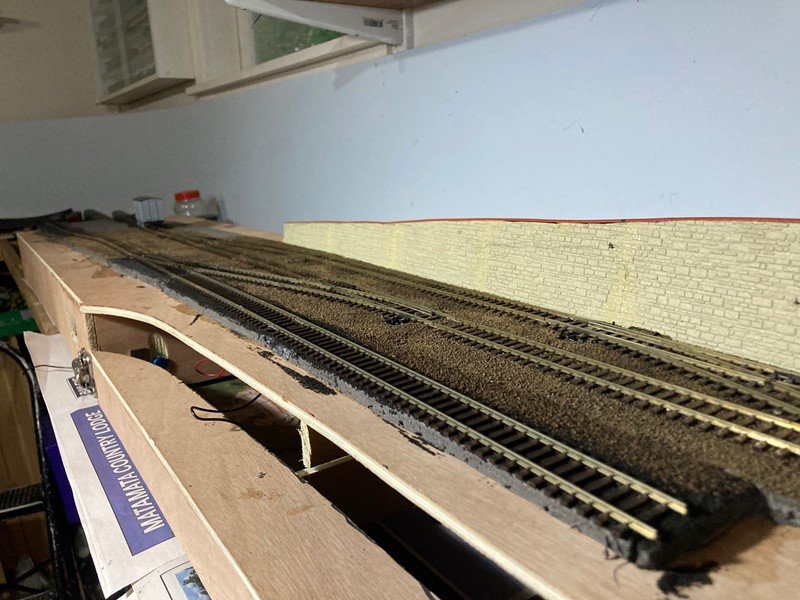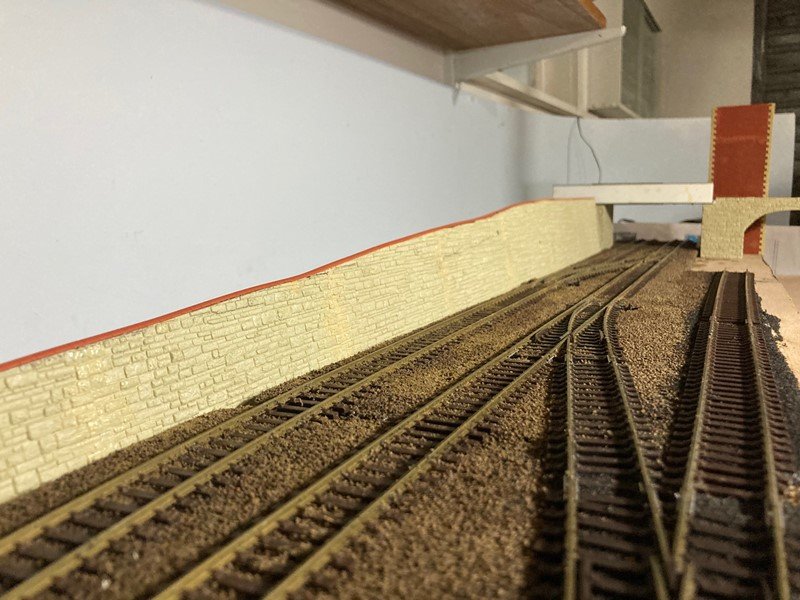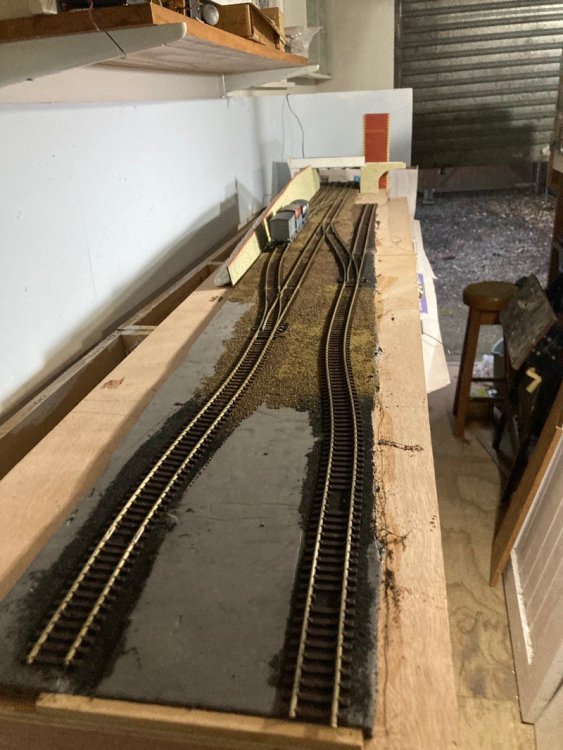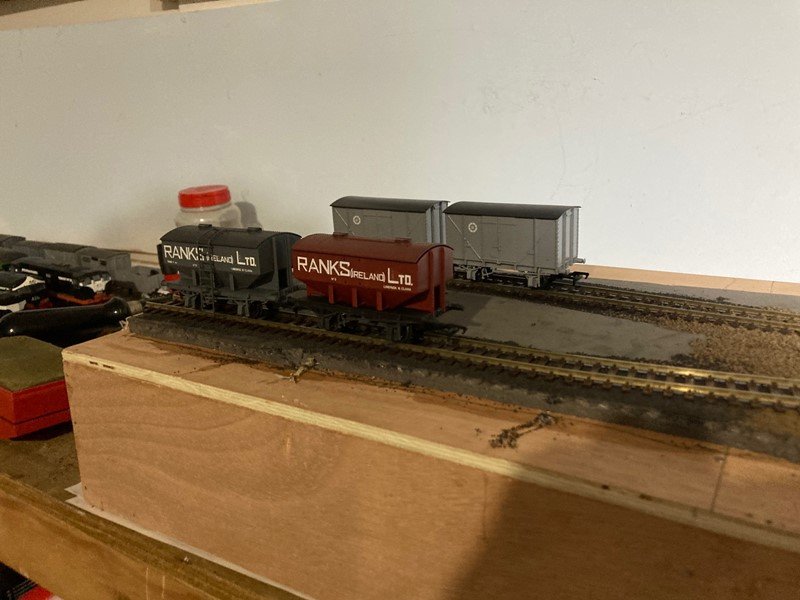-
Posts
4,882 -
Joined
-
Last visited
-
Days Won
119
Content Type
Profiles
Forums
Events
Gallery
Blogs
Community Map
Everything posted by Mayner
-
That takes me back I had a brief fling with BR 'modern image" modelling during the early 1980s and converted a second hand Triang 37 into a Scotrail with split headcode boxes (Crownline) and yellow nose. I have a green Jouef Class 40 somewhere with Crownline detailing, last oepend the box about 20 years ago
-
Apparently a lot of NCB (National Coal Board) locos, stock and track remain entombed underground following mine closures during the 1980s(I had some friends from the industry). Pumps were turned off, shafts capped and mines allowed to flood, there was no further use for the equipment and recovery would have cost more than the scrap value of the metal and the government wanted shut of the NCB and the miners.
-
A bit like a more modern elegant version of the Dutch style engines designed by William Adams (who else) for the North London Railway in 1868. https://picclick.co.uk/North-London-Railway-Adams-4-4-0T-Tank-Locomotive-164702035379.html
-
Both Loughrea and Balinrobe had 42' turntables & two road sheds to a standard MGWR design 60'X29'4" (Baronial Lines, Padraic O'Cuimin 1972). London Road Models and possibly Midland Railway Centre (Metalsmiths) produce 45' deck turntables https://www.rmweb.co.uk/community/index.php?/blogs/entry/17974-building-a-london-road-models-50-turntable/ similar to those used in Ireland. Ballaghadereen is unusual the track layout is not typical of MGWR branch line terminals as it was planned as a through station by the Sligo & Ballaghadereen Railway, at one stage there were plans to extend the line to Ballyhaunis to feed cattle traffic from County Roscommon and County Galway as an all Midland route to Sligo & Collonney in an attempt to keep the WLWR & GSWR out of Sligo and Mayo. There was no signal cabin the crossover from the main running line to the loop at the Kilfree end of the station was controlled by an open lever frame, the remaining points are hand operated. The most unusual feature is that the short headshunt to the cattle bank which made shunting difficult at the big fairs, the cattle bank could accommodate 24 wagons only 8 wagons could be released at a time due to the short headshunt. It looks like there was a carriage shed on the continuation of the running line beside the Goods Shed, this is likely to have been removed to reduce property rates in GSR days.
-
Is she 15" rather than 7½" gauge? Colour does not bother me the owner paid the money and made his or her choice. Sounds (chuff) like a full sized rather than a miniature loco, would probably need a transporter to carry it rather than a car trailer, generous curves and adequate roadbed with decent ballast and track to run on.
-
Try a motor aerosol primer and satin black rub down the surface with fine wet and dry before spraying, you will achieve a similar finish to a rtr loco. My biggest step in modelling was when I stopped brush painting locos and carriages about 40 years ago took a lot of practice both modelling and painting but I never looked back.
-
There is little new to report this month. We are currently fulfilling orders for the 1960s and 70s versions of the CIE Brake van and open wagon in etch primer and all three versions of the CIE 4w passenger rated vans. The majority of the 4w vans are pre-sold with one Luggage and on PO Van kit available at $150nz excluding shipping. I have finalised the graphics for the ready to run GSR/CIE IRCH Open wagon and 17012-17211 series Covered Wagon, I expect to complete decorated samples of these wagons Jan/February 2022 (Like the Chinese New Year everything in New Zealand shuts down from Christmas until late January) I have ceased accepting orders for the decorated versions of the grain, open and covered wagon until I am satisfied with the decorated samples of these wagons, in the interim the wagons are available in un-decorated or etched primer finish. I expect the decorated versions of the models to be available on the website from February 2022 with delivery expected April-May 2022. The etch primer is intended to protect the model from UV light, highlight excess support material during clean up and provide a key for painting the model, we use an proprietary adhesion promoter to ensure that the etch primer adheres to the resin model. The business that printed our prototype models has agreed to carry out our production printing, which has reduced the lead time for the manufacture and delivery of undecorated and primed models which should flow through to the manufacture of decorated models. These wagons are printed in a resin with ABS properties in a full size 'bottom up" printer, the resin is resilient less brittle than models printed in conventional modelling or in "tough" resins. Undecorated Grain Ladder Side Undecorated grain discharge side. The wagon is printed in 4 pieces. Ladder, roof, hopper body, one piece chassis including hopper discharge gear, brake gear and NEM coupler mounting brackets. All parts are designed to interlock, the hopper body literally fits into a rebate/socket in the wagon chassis and can be secured in place with super glue or 5min. epoxy during final assembly after painting. Unpainted GSR/IRCH Standard Open. One piece Body and One piece Chassis assembly as Grain wagon. 17012-17211 series Covered Wagon undecorated or etch primer. Roof, One piece Body, one piece Chassis
- 3 replies
-
- 10
-

-

-

-

Narrow Gauge in the Rockies not quite
Mayner replied to Mayner's topic in US / Canadian Railway Modelling
I finally caught up with the backlog of gardening and property maintenance after the winter and spring growth and had time for an operating session of the garden railway using Train Manifests I created using JMRI Operations in 2019! The first task was to position some stock on the layout so there was the outgoing trains did not return with the same freight cars!. K27 463 & RM 4 on shed stock cars positioned on Track 3. 463 had worked a freight from the staging to Jackson City with stock cars and General Manifest (Boxcars, Gondolas and a Tank Car the latter are positioned in the yard hidden behind the Engine House. No 4 worked an empty Mail/Passenger and will return with the next days scheduled train. Caboose parked on Track 3 opposite the Depot. 1:20.3 stock has a lot of (easily damaged) detail Manifest for Freight PL-JC4 The train number/designation follows American and New Zealand practice. Even numbered trains are usually South or East Bound Placerville is a real place on the Rio Grande Southern, most Railroads in Colorado planned to reach the Pacific or at least cross the state line into Utah, Jackson has a family connection and the first person to occupy our house almost 100 years ago was a Jackson, hence Jackson County & Jackson City. Train made up and ready to go, its easy to read the individual car numbers in 1:20.3! 348 is working the train as 461 is un-available & 464 is waiting for a new set of batteries PL-JC4 arriving at Jackson City the train is approaching the summit of on a 2% grade which can be challenging with slipping by both 2-8-0 and 2-8-2 locos in greasy rail conditions. The yard in the background is level, the boxcars are due to be spotted outside the Freight House (Goods shed) for loading with ore (silver or possibly uranium) Silver ore was transported loose in box cars (to avoid freezing) on the narrow gauge, the last box car may be transporting beer and other essential supplies for the local inhabitants. Beer tended to be transported in Reefers or refrigerated cars to avoid freezing in winter and over heating in summer the Colorado Rockies have a rather extreme climate! 348 pushing her train into the yard having already dropped her caboose on Track 3 Boxcars spotted for loading, American Railroads used removable gangway/bridges for loading boxcars on parallel lines. 781 is a drop bottom gondola (hopper) originally used to transport coke to the Durnago smelter but later used for transporting ash and ballast, while the DRGW modernised it steam motive power during the 1920s & 30s it continued to use wooden cars for coal and mineral traffic to the end of narrow gauge freight operations during the mid 1960s. The next scheduled freight working is a "Turn" (an out and back run) worked by 348 that will collect a Box Car and Gondola from Utah Junction and work then to Arboles the next town (station) along the line before running to Utah Junction to turn on the Wye collect a Box & a Stock Car for Arboles before working back to Jackson City. The JMRI programme is not bothered by a train working its way around a circle or reversing direction en route. Rail Motor 4 waits passengers, like the County Donegal the RGS turned to internal combustion in order to continue its mail and passenger services during the 1930s, being essentially bust the RGS turned to second hand car dealers and wreckers rather than building new. Passenger traffic was extremely light half a dozen passengers seems to have been a good load. Beeb and Clegg describe a ride on in an RGS Goose in Mixed Train Daily, a couple of enthusiasts, a Native American family outing and a decrepit ol timer going to Telluride for a shot or two of bourbon to break the monotony of a lone existence. Some day I got to model that Native American family with the Women and in their Sunday finest and a stoic Brave escorting the party. Moving the stock out to the garden gave me a chance to change 464s batteries as after 4 years the batteries were no longer holding a charge and the loco was unable to haul a 8-10 car train up the 4% grade to the staging. All locos use pairs of 7.2v RC car batteries the majority 3000mAh capacity. There is no real equivalent of NMRA DCC plug and play in large scale battery RC, the nearest was a standard interface used by Bachmann on its K27 all my brass locos are hard wired. The object on top of the Bachmann board is a power regulator/speed and direction controller. The purple yellow brown and white leads connect to a Phoenix sound decoder hidden below the tank filler. The small "decoder" with the red antenna and the untidy leads is the actual radio receiver. -
Irish Steel had a similar operation at the Haulbowline between the 1970s and the closure of the mill during the 1990s. The system was 4'8½" gauge and use second hand flat cars and gondolas imported from the United States and a Unilok tractor possibly built in Galway! https://www.unilok.ie/ A good excuse to model an Irish railway in HO with rtr American stock and an Irish shunting tractor.
-
A set of good quality needle files would be a good starting point for scratchbuilding/ kit building. As Northroader stated it would be simple enough to file the crescents to go round the bumps with a half round needle file. An alternative would be to use the chassis (provided the Radial Tank body and chassis are separate parts) and scratchbuild a body out of plasticard or even metal. That way you can sell the loco as a Radial Tank if the conversion does not work out. Personally I always found it easier to build something from scratch than to re-build a rtr model into something completely different.
-
I am very tempted only have to convince the rest of the family to move 12,000Km
-
How about one of the WLWR tanks used by GSR & CIE on the Clonakilty and Baltimore branches. Should be simple enough to fabricate the side tanks out of plasticard
-
No rust or missing doors when 019 was initially stored outside Diesel No 1 in 92/93. 019 received an overhaul and full repaint in the tippex scheme with points logo but never re-entered service approx. before being used as a guinea pig for the 201 paint scheme. The loco was in pristine ex-work condition in 010s old spot outside Diesel No1 when I visited Inchacore Works in 92 or 93 but was still in the same spot partially re-painted in the new scheme 12 months later. The remains of 010 was stored on Pullman Bogies outside Diesel No 1 following its recovery from the Lisburn collision until 019 took her place.
-
Well done nothing like getting stuck in using traditional scratchbuilding techniques as opposed to overanlysing the whole business and getting no where. Will she be Blacklion as Blacklion or after the re-build with Glencar's boiler and superstructure? The North Wales Narrow Gauge did much the same thing re-building the single Fairlies Snowdon Ranger & Moel Tryfan into one usable loco during WW1 when Moel Tryfan retained her identity despite receiving Snowdon Ranger's chassis/power bogie.
-
Going off on a tangent C Hamilton Ellis had a theory that William Adams designed the C&L 4-4-0Ts for Robert Stephenson there is a strong family likeness between his outside cylinder 4-4-0 & 4-4-2T locos and the C&L 4-4-0T in their original condition including stovepipe chimney.
-
I could not resist it and had to do a running test to check whether I had succeeded in acoustically de-coupling the track from the plywood baseboard, my past experiences with cork underlay was that ply baseboards are very effective sounding boards/resonators. The clip was very short as I tried to maximise dept of field which did not leave the camera processor with too much leaway. I am fairly happy with the result and will probably use the same principals when I get round to building a 21mm gauge layout on the baseboard framing that sits below East Dock. I took some photos using aperture priority setting at f22 on the SLR using the baseboard as a tripod to see what could be achieved with the narrow aisle on this side of the workshop/model railway room. Reasonable depth of field with A23r in focus at a distance of approx 800mm. The baseboard joint is sitting on miniature clamps creating an unintentional impression of distance/curvature of the Earth effect . The retaining wall got a coat of primer a base for painting the stonework and hopefully disguising the vertical panel joints. A23r hauling her train into the loop most of the train is in focus. The 'dropoff" will be modelled as a quay wall with paving just below rail level. The old style BR containers usually appear to have been transported in open wagons into the early possibly mid-1970s, possibly lifted on-off with Coles self propelled cranes containers apparently used for BMC auto parts traffic. The Bachmann containers make a nice load, opens also used to carry farm machinery, in addition to traffic like timber, bricks from Kingscourt, bagged fertiliser and bulk traffic including gypsum, beet, peat briquettes.
- 56 replies
-
- 12
-

-
A Peco or Hornby uncoupling ramp or even a piece of flexible plastic is probably the best option for tension lock couplers such as Dapol, which are not really suitable for magnetic operation without serious modification. The Peco SL 29 "Decoupler" is designed to fit to Code 100 track https://peco-uk.com/collections/100/products/rh-decoupler but may be suitable for Code 75. We used Peco or possibly Hornby uncoupling ramps with Code 75 track under exhibition conditions for two days without a problem shunting and running round stock with tension lock couplers on a layout that otherwise used Continental style hook and loop couplers with magnetic uncoupling. The advantage of the Hornby or Peco uncoupling ramps is that you can experiment by moving them around until you find uncoupler locations that suits the way you operate the layout. A piece of flexible plastic as an uncoupling ramp, ends wedged in place by sleepers, experimentation needed to identify plastic with suitable flexible properties and ramp length, that a pair of coupling hooks can rise clear of bar, but long enough and flexible enough to deflect when hauling a train across ramp. Hornby also produce an uncoupler that can be converted to powered operation using a point motor.
-

Self propelled cranes and small coasters
Mayner replied to David Holman's question in Questions & Answers
Interestingly I once spoke to Robin Clements and he considered the J18 rebuilt with Inchacore cab and X superheater boiler to be a Southern rather than a Midland engine. I think Rices point was that the ex-GSWR J15 was considered ubitiqous on the Southern system which is reflective of most writings on Irish railways at the time, at a practical level the TMD J15 kit or scratchbuilding a MGWR 0-6-0 are the only options. While Midland engines generally stuck to their territory there is photographic evidence of GSWR 0-6-0s working goods trains on the Midland in CIE days. Interestingly the section on Westport Quay in Rices' book includes a nice sketch of a J26 complete with CIE era riveted smokebox and Inchacore chimney although the kit is only available in its original pre-1912 form. 7mm is probably the best option for modelling the MGWR in the GSR/CIE era with a good range of loco and coach kits and easier to work in the larger scale than 4mm. -

Self propelled cranes and small coasters
Mayner replied to David Holman's question in Questions & Answers
The TMD (Terry McDermott) Midland tank and J15 were the only suitable small Irish steam locomotive kits available for a GSR or CIE layout when Iain Rice wrote "An approach to Model Railway Layout Design Finescale in Small Spaces" in 1990, the situation is basically unchanged 40 years later. In Light Railway Layout designs Iain transformed the Westport Quay concept into Isle of Whithorn a Scottish roadside tramway terminal modelled complete with quayside branch and harbour a cross between PD Hancock's Craig (quite fittingly) and Jim Harrison's Torpoint both influential layouts between the 50s & 70s. Personally the Isle of Whithorn layout is visually and operationally more attractive than Westport quay, a roadside tramway section, the loco spur having a loco shed and a harbour scene in which the buildings form a backdrop to the railway. At the time most of Iain Rice's writing were aimed at the fine scale modelling fraternity that prefer the challenge of hand laid track and kit or scratchbuilt stock to EM or S4 standards and hand built building. -
A bit more progress this weekend. I had originally planned to use Peco Point Motors with baseplates and extended drive pin salvaged from an N gauge layout, but decided to fit the motors directly to the points to eliminate the risk of lost motion with the extended drive pin and floating track base. The first job was to accurately fit and test run the track before cutting out the holes in the baseboard for the point motors, at the same stage I drilled holes for the power droppers, I cut out the holes for the point motors using a drill and jig saw, test fitting the point/point motor subassembly as work progressed, the hole in the top right hand corner has to be squared up.! Test fitting and checking alignment of point work and main running road on one board checking that the running road aligns with a point on the second board. Its necessary to cut the hole longer and wider than the headblock timbers to allow the motor to fit through, I infill the excess with black paper before ballasting the track The tricky potentially messy bit track lifted on packers before gluing and ballasting showing droppers to DCC track power bus. Track bedded in office glue aligned and lightly pinned in position, I was a bit to generous with the glue on this first section. Ballast sprinkled on and pointwork installed on second board. Underside of baseboard showing power droppers and point motors. I had shaken off excess ballast at this stage. Tracklaying and ballasting complete. I used fine ash ballast on some of the siding roads and a medium brown on the running line and loop, the difference in shading is probably related to the drying of the glue. Looking back towards the staging From the buffers the lines in the foreground are supposed to have been re-aligned in the 30s when a new grain feed store was built. I may inset the track on the right with cobbles or concrete as its supposed to be part of a quayside line or simply treat as a railway siding as it would be tricky insetting the point and not look very good in OO. I will do any necessary topping up of ballast covering baldspots by dry ballasting and gluing with dilute office glue and a wetting agent using an eye dropper. The glue is a white office glue which hopefully is more resilient than a woodworking pva. It will be interesting to see whether noise transmission from the track to the ply becomes a problem (especially locos with sound), the track is basically floating on foam underlay and will only be fixed rigidly at the baseboard joints, this layout is basically a test bed for a permanent 21mm gauge layout if it ever gets built. The Mill/Feedstore area the hoppers are spotted for unloading over the intake pits, the vans spotted for loading feedstuff from the dry store. I am almost tempted by Ranks Clara which had quite grusome corrugated iron grain elevators and stores in contrast to the massive brick and stone 18th and 19th Century maltings and mills.
- 56 replies
-
- 14
-

-

-
There was a king of inferiority complex about Irish railways and particularly CIE when I first joined a club in the early 70s, the majority of members modelled British, Continental or American outline, Irish railways particularly the GNR tended to be modelled by craftsmen for the challenge of modelling something different and novices like myself who could only afford second hand Tri-ang. People who wanted quality models and reliable running tended to buy and collect Marklin, Fleischmann, Trix and Rivarossi Continental while a smaller number collected Wrenn and Hornby Dublo, a few collected Athearn, Walthers and Atlas but the running quality and detail of American stock was not great until Walthers and Atlas commissioned Roco in Austria and later Kato in Japan to produce locos during the 1980s. Irish outline became more main stream with the introduction of kits and later rtr models from the mid 1980s, but I suspect like NZR modelling in New Zealand remains a minority interest compared to modelling and collecting British, Continental and American models. Curiously despite New Zealand modelling having a high profile with a national guild similar to the NMRA that published a quarterly magazine available in book and magazine stores nationally and the availability of a comprehensive range of kits produced by several manufacturers in three scales , its still pretty much a minority interest and no manufacturer has commissioned high quality models of New Zealand locos and stock. British, Continental and American modellers have all established national groups, the New Zealand Model Railway Guild, AMRA (American Modellers) and Garden Railway Associations host bi-annual national conferences with regional annual conferences. Because of its craft base the standard of NZR modelling tends to be higher and more realistic than mainstream British, American and Continental modelling, with realistic scenery and structure modelling including accurately modelled native trees, vegetation and land form (either flats or mountain), birds, animals human figures, buildings and structures. Clubs are not all in major cities some are small remote centers, Athlone is a large town by any standards
-
Interesting mainly West Cork, South Eastern and Midland wagons with a small number of GSWR/GSR. I wonder had they been carded/withdrawn/broken up and Carriage & Wagon Department not informed the Traffic Department or the Control Office. Railways are famous for siloed thinking I had some interesting interactions as a HSA inspector with IE about 20 years ago and quickly I found out that Signal and Electrical did always not keep Permanent Way in the loop about things they were doing on or very close to the line.
-
Reminds me of a fire drill during the construction of a large Watford shopping center during the late 80s. Although there was relatively little of a flammable nature on site we were constructing the concrete frame the company recently had major fires on two of its most prestigious London sites and an order went out from head office for a fire drill on every site. Anyway to get to the heart of the story, my job was to physically check that the site was clear after our trade contractors managers and foremen had completed a head count that the site was clear. Like Harry a concrete finisher was diligently chipping away with his hammer and chisel wearing ear defenders inside a plant room. At the time apart from safety helmets and steel toe capped boots construction workers seldom wore ppe, our concrete finisher was probably the only one of the over 100 workers on site to wear hearing protection, being already a bit deaf he did not hear the klaxon and preferring to work apart from breaks he was invisible to his work mates and his boss forgot to check. The look of surprise when he realised that he was the only one on site was something else, al those were the days!
-
Interestingly Colin Flannigan appears to have built his first BCDR 4-4-2T out of a Ks Adams Tank Loco kit during the 1970s
-
Nice to see these Triang(-Hornby) upgrades, their main line diesels & MK1 coaches were cutting edge models by the standards of the day and still pass muster 60 years later.
.png.c363cdf5c3fb7955cd92a55eb6dbbae0.png)

